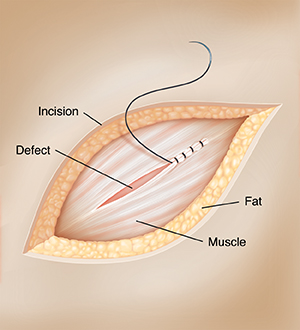Having Hernia Surgery: Traditional Repair
Surgery treats a hernia by fixing the weakness in the abdominal wall. A cut (incision) is made so the surgeon has a direct view of the hernia. The repair is then done through this cut. This is called open surgery. To fix the problem, muscle and connective tissue may be sewn together to make a “traditional repair.”
Follow your healthcare provider’s advice on how to get ready for the procedure. You can often go home the same day as your surgery. In some cases, you may need to stay in the hospital overnight.
Getting ready for surgery
Your healthcare provider will talk with you about getting ready for surgery. Follow all the instructions you’re given. Be sure to:
-
Tell your healthcare provider about any medicines you take. This includes both prescription and over-the-counter medicines. It also includes any vitamins, herbs, and other supplements.
-
In general, stop taking aspirin, ibuprofen, naproxen, and other nonsteroidal anti-inflammatory drugs (NSAIDs) 3 days before surgery, or as directed. But if you take aspirin, or other antiplatelet medicines, for a heart condition or a past stroke, talk with your provider before stopping them.
-
Plan to have an adult family member or friend there to give you a ride home after surgery.
-
Stop smoking. Smoking affects blood flow. It can slow healing.
-
Gently wash the surgical site the night before surgery. You may be given a special scrub to use.
-
Follow any directions you're given for not eating or drinking before surgery.
The day of surgery
Be at the hospital or surgical center at your scheduled time. You’ll be asked to change into a gown. You’ll then be given an IV (intravenous) line for fluids and medicine. Shortly before surgery, an anesthesiologist will talk with you. They'll tell you about the types of anesthesia used to prevent pain during surgery. You'll have one or more of these:
-
Monitored sedation to make you relaxed and sleepy
-
Local anesthesia to numb the surgical site
-
Regional anesthesia to numb certain parts of your body
-
General anesthesia to let you sleep during surgery
Risks and possible complications
Hernia surgery is safe. But it does have risks, such as:
-
Bleeding
-
Infection
-
Anesthesia risks
-
Inability to pee
|
-
Numbness or pain in the groin or leg
-
Risk the hernia will come back (recur)
-
Damage to the testicles or testicular function
-
Bowel or bladder injury
|
During the surgery
To make a traditional repair, a cut is made over the hernia. The muscle tissue around the weak area is then sewn together to fix the defect. The cut is closed with stitches, staples, surgical tape, or special glue. This method can be used to fix any type of hernia. Nontraditional surgery includes using mesh or laparoscopic surgery. These are not discussed here. Your surgeon will decide which type of repair is best for you.

After surgery
When the procedure is over, you’ll be taken to the PACU (postanesthesia care unit) to be watched. Your blood pressure, breathing and heart rate will be monitored. You’ll also have a bandage over the surgical site. To help reduce discomfort, you’ll be given pain medicines as needed. You may also be given breathing exercises to keep your lungs clear. Later, you’ll be asked to get up and walk. This helps prevent blood clots in the legs. You can go home when your healthcare provider says you’re ready.
Make sure you understand your aftercare instructions. Know how to care for your incision and what physical restrictions you may have. Don't do any heavy lifting for several weeks after the surgery. Follow-up with your surgeon as directed.
Online Medical Reviewer:
Heather M Trevino BSN RNC
Online Medical Reviewer:
Robyn Zercher FNP
Online Medical Reviewer:
Ronald Karlin MD
Date Last Reviewed:
4/1/2024
© 2000-2024 The StayWell Company, LLC. All rights reserved. This information is not intended as a substitute for professional medical care. Always follow your healthcare professional's instructions.